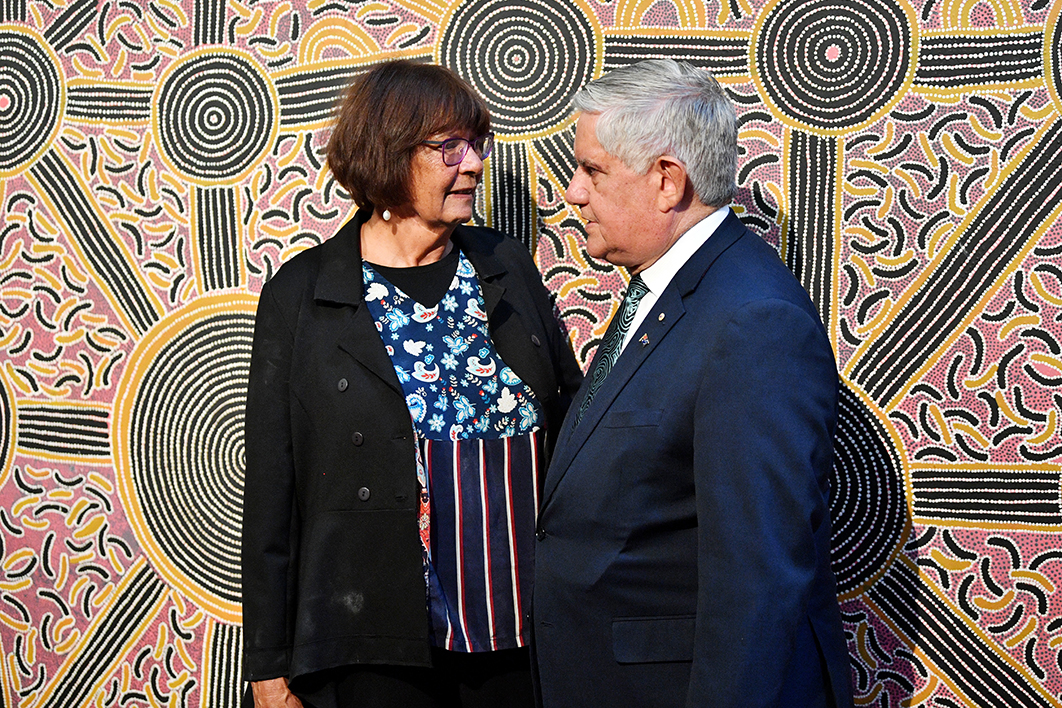The Closing the Gap reports, released at the beginning of each year’s parliamentary sittings for more than a decade, have become an increasingly controversial symbol of our collective failure to tackle Indigenous disadvantage. In late 2016, keen to reassert control over the policy narrative, the federal government committed to a “refresh” of the Closing the Gap targets; in response, a group of fourteen community-controlled peak bodies proposed a formal partnership to develop a new strategy. The Council of Australian Governments established a partnership with Indigenous interests in March 2019.
A subcommittee of COAG, chaired by Indigenous Australians minister Ken Wyatt and Coalition of Peaks chief executive Pat Turner, oversaw negotiation between Indigenous interests and all levels of Australian governments. The result, the National Agreement on Closing the Gap, released in late July, provides an opportunity to assess the ramifications and effectiveness of the Indigenous groups’ involvement in the process.
The agreement included not only sixteen new targets — mostly in policy areas that are primarily state and territory responsibilities — but also a series of priority reforms for joint national action. The latter, included at the insistence of Indigenous interests, were designed to tackle the systemic and structural underpinnings of Indigenous disadvantage; they focused on formalising Indigenous involvement in policymaking related to programs and services; strengthening Indigenous community-controlled organisations; transforming the operations of government organisations to improve accountability and responsiveness; and improving access to data.
The reaction to the new agreement has been mixed, focusing overwhelmingly on the scope, rationale and shortcomings of the sixteen new targets and the absence of other targets. Although a significant segment of public opinion (both mainstream and Indigenous) appears to be supportive of the aspirations and content of the new agreement, widespread scepticism has also emerged. Critics point to the targets’ lack of ambition, particularly in relation to incarceration rates and family violence, and the absence of the investment needed to ensure they are met.
Nationally, Labor and the Greens support the new national agreement, but both parties have called for extra funding. The most surprising criticism came from prominent architects of the Uluru Statement from the Heart, who pointedly questioned the representativeness of the peak organisations that negotiated with governments — a development that raises complex issues about how Indigenous interests are represented and advocated more widely.
Despite this debate, some of the key implications of the new partnership agreement have been overlooked.
The best way to unravel the deeper policy implications of the new Closing the Gap targets is to consider what each of the parties to the agreement — the Commonwealth, the states and territories, and Indigenous interests — were seeking.
While the governments’ objectives were opaque, their shape can be discerned by analysing past policy approaches and by reverse engineering the final agreement. It would be naive to take the public rhetoric of governments regarding their objectives at face value; for example, the Commonwealth refused access to an evaluation of the National Indigenous Reform Agreement, the COAG document that established the Closing the Gap targets in 2008, on the basis that to do so would reveal “deliberative processes” regarding the negotiations.
In my view, the Commonwealth is likely to have had four objectives in refreshing Closing the Gap:
• to shift the goalposts so as to diminish the significance of the annual ritual admission of failure to meet its targets (the “humiliation driver”)
• to avoid structural or systemic policy reforms that are necessary for greater Indigenous inclusion yet would impose unacceptable political costs (the “policy stasis driver”)
• to avoid significant new and ongoing financial investment in addressing Indigenous disadvantage (the “deficit driver”)
• to shift political and financial responsibility for Indigenous services to the states and territories to the maximum extent possible (the “fiscal federalism driver”)
All of these drivers are mutually reinforcing, and their attainment would combine to compound and reinforce Indigenous exclusion.
Because the original Closing the Gap targets, fixed by COAG, were expiring, the Commonwealth was able to corner the states and territories. The premiers and chief ministers were already at the table, and couldn’t easily avoid engaging. In many respects, they also share those four objectives, except that their fiscal federalism driver points in the opposite direction. Above all, they would want to ensure that the Commonwealth doesn’t offload responsibilities for servicing Indigenous citizens and communities without providing funding too, and to ensure that the agreed targets can be implemented and assessed flexibly. In theory, they could have pushed back, but the Commonwealth had cleverly brought Indigenous interests into the design of its strategy, making it politically harder for the states and territories to resist a new negotiation.
The Indigenous parties to the process were the most transparent. The Coalition of Peaks had laid out its overarching agenda in a number of public forums. It had no choice but to do this openly, because it had to build, and importantly sustain, an alliance of disparate organisations with no established organisational infrastructure. The Peaks’ initial core objectives (as set out on its website) were fourfold: shared decision-making, community control, structural transformation of government agencies, and better access to data.
Spelling out these objectives of the parties helps clarify the dynamics of the refresh. First, the Commonwealth’s fiscal dominance and legislative heft outweigh the states and territories individually and collectively, and its policy objectives — though never made explicit — are more straightforward and encompassing.
Second, the parties’ objectives are not “mirror images”: they don’t involve zero-sum calculations and therefore allow for win/win outcomes (admittedly constrained by the respective ambition and comparative strength of the parties).
Third, the Indigenous objectives were, of necessity, dependent on ongoing commitment and implementation by governments, whereas the governments’ objectives were not dependent on Indigenous responses and were essentially one-off decisions, albeit with longer-term institutional implications.
Fourth, while Indigenous interests traditionally prefer more rather than less Commonwealth engagement, it seems likely that they faced a trade-off between their own objectives and supporting the states in resisting Commonwealth disengagement. Their focus on building Indigenous capacity lessened their ability to insist on mechanisms to pressure on the states and territories to wholeheartedly implement the necessary policies.
Finally, a further “interest” is at stake in these negotiations — namely, the wider public interest — though it is inchoate and intangible and has no seat at the table. This interest transcends the partisan and institutional interests of governments and oppositions, and extends beyond the preoccupations of the current generation of Australians. It posits a simple question without easy answers: how might the negotiations contribute to the sort of nation we hope to bequeath to our children and their children?
While it will take some years for the agreement’s tangible outcomes to emerge, an informed assessment of likely outcomes is possible now that we know the detail of the proposal. After all, the strategists and insiders within each party who determined what was and wasn’t on the table made just such an assessment.
My own assessment, against the notional objectives of the parties, is as follows.
The Commonwealth, by achieving all of its likely objectives with minimal political cost, is the big winner. It has retreated from its overarching national policy role to essentially become a mere aggregator of statistics. By strenuously advocating the notion of shared accountability, and by choosing targets that overwhelmingly relate to state and territory responsibilities, it has shifted the responsibility for explaining failure largely to the states and territories, and to a lesser extent to Indigenous interests.
Importantly, the proliferation of implementation plans and performance data across eight jurisdictions and against sixteen (plus) targets, most of which are required to be disaggregated into four or more categories, will create an extraordinarily complex maze of outcomes to be monitored, assessed and (in theory) adjusted as necessary by policymakers. Commonwealth ministers will sleep soundly at night in the knowledge that when everyone is accountable, no one is accountable.
The Commonwealth’s success in avoiding policy responsibility is not just about Closing the Gap. It is the culmination of a decade-long push to shift Indigenous policy responsibilities away from the Commonwealth and towards the states and territories, and away from Indigenous-specific programs and towards mainstream programs. On issues as diverse as heritage protection, essential services, Indigenous housing and legal aid, the Commonwealth has been reducing its footprint. Where it retains responsibility — in relation to income support, for example — it has increasingly turned to mainstream programs rather than Indigenous-specific ones. The new Closing the Gap agreement is a major capstone on a pre-existing trend that will shape Indigenous policy for generations.
Measured against their assumed objectives, the states and territories have emerged from these negotiations as losers. They will each be obliged to develop detailed implementation plans against the various targets and introduce the necessary policies to deliver them. They receive no extra funding, which means they must either raise extra revenue or borrowings, cut services elsewhere, or — perhaps most attractively from their perspectives — find ways to replace tangible actions with rhetoric (which would shift the loss to Indigenous interests).
Assessing the outcomes for Indigenous interests is not straightforward. The first-order issue is that they leveraged their partnership status into an ongoing role in overseeing Indigenous service delivery both in Canberra and in the states and territories. If implemented, this is of huge strategic importance: it would be the first time Indigenous interests are present when decisions with life-changing implications are being made.
Second, the new national agreement gives Indigenous interests a commitment by the governments of eight jurisdictions, plus local government, to a new policymaking approach based on partnership and greater community control of service delivery. This commitment is built around a formal cross-jurisdictional agreement to four overarching priorities:
• Shared decision-making, including a joined-up approach to five policy priority areas and the creation of six place-based partnerships between all levels of government and relevant communities.
• Sector-strengthening plans in priority areas, starting in early childhood care and development, housing, health and disability.
• Transformed government organisations focusing on issues such as cultural safety, improved engagement with Indigenous organisations and, importantly, improved accountability through more transparent funding processes.
• Shared access to data and information at a regional level.
Implemented effectively and with imagination, these reforms will be far-reaching and will fundamentally increase the influence of First Nations people in policymaking across the nation. To have them embedded in a formal agreement signed up to by all levels of government in Australia is a monumental achievement.
Offsetting these nominal gains are two serious downsides for Indigenous interests; risks that I assess as both high-impact and highly probable. First, they will struggle to build — and, importantly, sustain — the organisational capabilities to engage persuasively and influentially both nationally and, most importantly, across eight jurisdictions. A “seat at the table” does not guarantee positive outcomes. This challenge will be more difficult if governments pursue strategies encouraging internal dissension.
The second risk is the one I foreshadowed earlier: that governments will avoid implementing, resourcing and sustaining the strategies necessary to achieve these reforms. Implementation failure is ubiquitous across Australian governments, even in contexts where policymakers have the best intentions and a relatively free hand. Nicholas Gruen recently framed this as a disjunction between what policymakers say and what they do; a problem he described as being endemic in policy circles. Memorably, he referenced Lord Acton’s observation on rowing as the perfect preparation for public life: moving in one direction while facing the other. The new agreement will require policymakers in a variety of jurisdictions to operate at levels of coordination and cooperation that are rarely achieved in mainstream services, and will require them to take account of Indigenous views in fluid policy and political contexts.
But are governments prepared to make such commitments? Two examples, incarceration levels and employment levels, suggest they may not be, and point to the likely impact of that failure on the lives of Indigenous citizens.
After a leaked version of the final agreement revealed a proposed (and not apparently ambitious) goal of parity in incarceration rates by 2093, Minister Wyatt announced that the target would be changed. The parties subsequently reframed the target as a reduction in Indigenous adult incarceration of 15 per cent by 2031. If achieved, according to the most recent data, this would bring the rate of Indigenous incarceration down from 2589 per 100,000 to 2201 per 100,000, against a mainstream incarceration rate of 223 per 100,000. After ten years’ effort, in other words, Indigenous incarceration rates would still be around ten times the rate of the wider community.
In relation to employment, Closing the Gap now aims by 2031 to increase to 62 per cent the proportion of working-age Aboriginal and Torres Strait Islander people who are employed. According to researchers at the ANU, around 47 per cent of working-age people — those aged fifteen to sixty-four — were employed at the time of the 2016 census, compared with 72 per cent of the non-Indigenous working-age population. The new target focuses on the narrower age range of twenty-five to sixty-four, sidestepping extremely low youth employment, both mainstream and Indigenous, and shifting the latter challenge to the target that focuses on youth employment, education and training.
Even if the new employment target is achieved, some 40 per cent of Indigenous citizens aged twenty-five to sixty-four — four out of ten — won’t be employed by 2031, with all the associated health and economic repercussions for individuals, families and the wider community.
If reducing Indigenous incarceration or increasing Indigenous employment were actually a real priority for Australian governments, these targets would be much more ambitious. In fact, their failure to commit to ambitious targets — and to the policy reforms and increased funding necessary to achieve them — clearly represents a lost opportunity for Indigenous interests. But it can’t credibly be argued that Indigenous negotiators — the party with the least negotiation leverage — bear responsibility for this outcome; instead it is a failure of governments to move decisively beyond the status quo.
Finally, what of the public interest? Australia’s continued failure to tackle deep-seated Indigenous disadvantage diminishes us all. The federal government’s ongoing retreat from policy responsibility is driven by short-term politics and doesn’t align with the expectations of the Australian population when they voted overwhelmingly in 1967 to give the Commonwealth the power to legislate in relation to Aboriginal people. More insidiously, the pretence and self-deception involved in reassuring ourselves that we are doing all that is possible, and that somehow the issues are “intractable” and thus insoluble, undercut the very integrity of our democratic culture. This is not a win for the public interest.
All of us, Indigenous and non-Indigenous alike, have a propensity to see politics and policymaking in terms of a destination rather than a journey. Yet, as we reach each milestone, others appear on the horizon.
The Closing the Gap negotiations saw Indigenous groups successfully demanding a role in developing future policies and programs, and forced governments to formally commit to structural reforms, shifting the nature of the journey ahead. Instead of the previously impenetrable terrain surrounding arid targets and arcane statistics, we now face a climb, admittedly steep, through more open terrain on which the milestones are more visible and are linked to a framework for developing further reforms. Despite my pessimism, the opportunities for the nation have expanded. •




